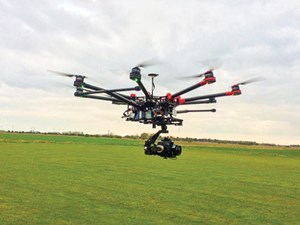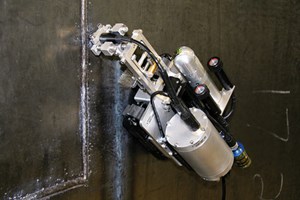
Unmanned aerial drones and waterproof crawler robots are changing the way that rig, platform and vessel owners perform inspections. These two new technologies bring better data while being safer, faster and less costly. Aerial drones can deliver streaming video of derricks, jackup legs and external rig surfaces, supplanting the need for rope access teams. Crawler robots reduce the need for divers and confined-space workers by providing real-time video and ultrasonic testing (UT) data, both above and below the waterline, and in tanks, empty or full. SkyNetUAVS has now set up shop in Houston with further plans to have a site in Louisiana.
These two enabling technologies allow asset owners and regulators to mobilize more quickly to a site and obtain information that previously might have taken weeks to secure. With both machines, the ability to easily re-inspect a given area brings new flexibility to any project, and planned and unplanned inspections are simple to execute without interruption to offshore operations. Client experts can view the situation from anywhere in the world as it is streamed in real time over the internet.
The aerial drones can fly in winds up to 30 knots and at heights exceeding 5,000 ft, Fig. 1. Surveying the outside and the inside of the derrick is possible, eliminating much of the rope-access work required for regular rig inspections. Applications include the survey of vessels, platforms, docks, terminals, flares and even the underside of semisubmersibles and jackups. SkyNetUAVS flying teams are made up of trained pilots accompanied by the clients’ inspectors, providing an immediate assessment of the equipment being viewed. In cases of product leaks, electrical issues or combustion, thermal imaging provides valuable information to the client without danger to personnel.

The crawler robots work both above and below the waterline and can navigate long distances while sending real-time video back to the client reps, Fig. 2. Operating on steel structures, or in tanks and pipelines, these machines provide real value with immediate results. The ability to take ultrasonic readings from inside or outside of a tank reduces the need to send personnel into confined spaces, eliminating the risks to men and equipment and the negative impact on rig operations. These crawler robots are powered via a tether and do not rely upon batteries if extended work periods are needed. They can navigate over barnacles and other marine growth, eliminating the need to jump divers or more expensive ROV’s. The robots can be fitted with a variety of tooling, from cameras, ultra-sonic probes, film thickness sensors and thermal pickups.
Condition-based maintenance is enhanced, when high quality information is available to the asset owner. Additionally, class and regulatory personnel make better decisions when precise images remove the ambiguity from accumulated inspection data. Fewer personnel, faster mobilization and reduced bed space requirements are additional benefits when aerial drones and crawler robots are part of the asset inspection process.
SkyNetUAVS provides both aerial drones and crawler robots around the world. The mobilization cycle is short, allowing the teams to reach the site in a minimum number of hours. Job days are significantly less, and the quality of the data is generally superior to traditional techniques. These new technologies represent a real step change in how rigs, platforms and vessels are maintained. ![]()
- Advancing offshore decarbonization through electrification of FPSOs (March 2024)
- Subsea technology- Corrosion monitoring: From failure to success (February 2024)
- Driving MPD adoption with performance-enhancing technologies (January 2024)
- Digital transformation: A breakthrough year for digitalization in the offshore sector (January 2024)
- Offshore technology: Platform design: Is the next generation of offshore platforms changing offshore energy? (December 2023)
- 2024: A policy crossroads for American offshore energy (December 2023)
- Applying ultra-deep LWD resistivity technology successfully in a SAGD operation (May 2019)
- Adoption of wireless intelligent completions advances (May 2019)
- Majors double down as takeaway crunch eases (April 2019)
- What’s new in well logging and formation evaluation (April 2019)
- Qualification of a 20,000-psi subsea BOP: A collaborative approach (February 2019)
- ConocoPhillips’ Greg Leveille sees rapid trajectory of technical advancement continuing (February 2019)


